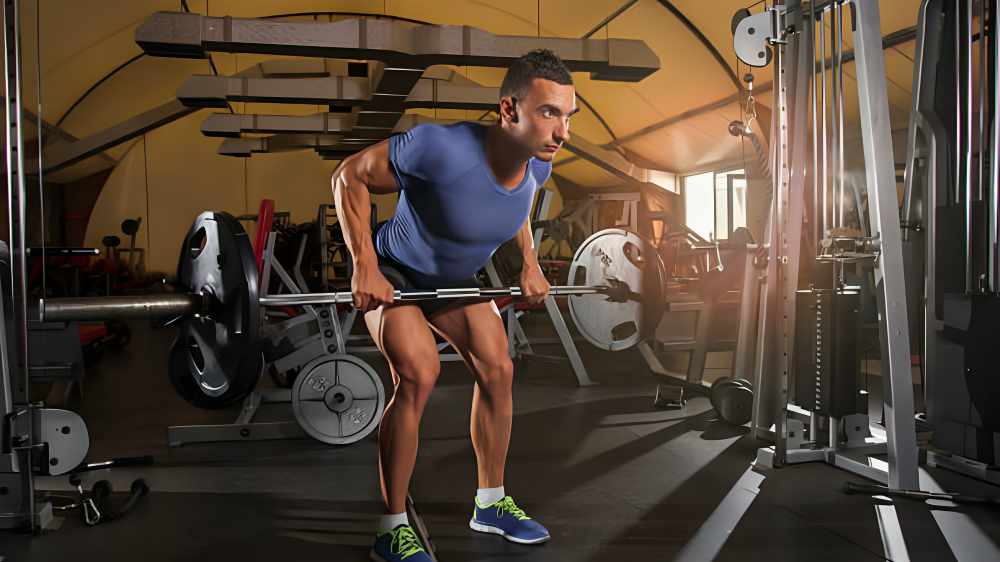
What Is the T-Bar Row?
The T-Bar Row is a compound exercise; it therefore engages a variety of muscles at the same time. In essence, this exercise works your back, particularly the middle and upper part, while putting additional focus on your rhomboids.
Simplistically explained, the T-Bar Row is a form of the bent-over rowing exercise in which one pulls a barbell or special T-Bar attachment toward the chest while maintaining a solid, stable posture.
How to Perform the T-Bar Row
Set Up the Equipment:
Take hold of either a T-Bar Row machine or wedge a barbell in the corner. In this case, load the opposite end of the bar with an appropriate weight. Not too heavy, especially if you are a beginner. Focus on the form first.
Get Into Position:
Similarly, stand over the bar with your feet shoulder-width apart.
Slightly bend the knees and then hinge forward from the hips. Remember to keep the back straight, chest lifted, and core bracing.
With both hands, firmly grip the handle or bar.
Row the Weight:
Pull the barbell or handle towards your chest, first by squeezing your shoulder blades together. Imagine you’re pinching a pencil between your shoulder blades; this ensures your rhomboids are doing most of the work.
Keeping your elbows close to your body, pull on the bar so that it approaches just beneath your chest. Do not flare your elbows too far out; this takes tension off of your rhomboids.
Lower the Weight:
Gradually release the weight back down into the starting position, allowing for full extension of the arms. Maintain tension in your back without letting your spine hunch forward.
Repeat:
Perform for 3-4 sets of 8-12 repetitions depending on one’s fitness level.
Benefits of the T-Bar Row
Targets Upper and Middle Back
Probably one of the best exercises for developing your upper and middle back, especially the rhomboids, is the T-Bar Row. Good, strong rhomboids protect your posture and also help in maintaining healthy shoulders, especially if one has to sit or work on the computer for long periods.
Improves Posture
Poor posture affects many of us, due to tight chest muscles and particularly weak back muscles. The T-Bar Row balances out the rhomboids, lats, and traps in your back, helping correct the forward slouch so many of us develop over time. Stronger back muscles will pull your shoulders back, correcting your spine and improving your posture.
Strengthens Other Muscle Groups
Although a back exercise by nature, T-Bar Row doesn’t pass the chance to work your biceps, forearms, and core in one swift motion; your biceps start to assist during the pull, whereas your core is going extra hard, stabilizing your body. This hence makes this exercise effective since you get much more out of it other than just plain back strength.
Builds Back Thickness
While exercises like pull-ups and lat pulldowns are great for building width, the T-Bar Row adds thickness to your back. If you want that well-rounded, muscular look, this exercise should be a staple in your workout routine.
It’s Here Barbell Bench Press Upper Chest how to do it and what are the benefits
FAQs
1. How often should I do T-Bar Rows?
It’s ideal to add T-Bar Rows to your back or pulling workouts 1-2 times per week, depending on your overall routine. Give your back muscles adequate time for recovery between sessions.
2. What can I do if I don’t have access to a T-Bar Row machine?
You can easily replicate the movement by wedging a barbell into a corner and attaching a close-grip handle to the free end. Landmine rows are another great option.
3. Can beginners do T-Bar Rows?
Of course! With lighter weights, one can learn the proper form and master it. Later, they can increase the load with gains in strength.
4. Should I be lifting heavy or going for higher reps?
It really works both ways depending on what you want. Go heavy with fewer reps like 4-6 if you’re training for strength, and go light doing higher reps like 8-12 if you want to target muscle endurance and hypertrophy.

